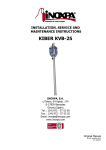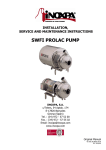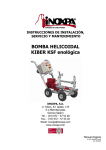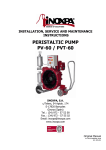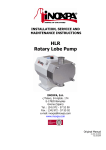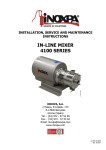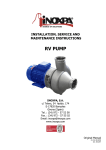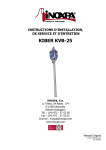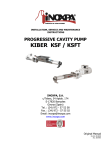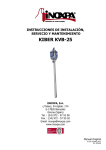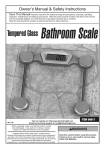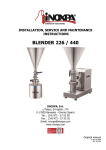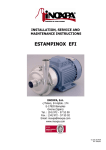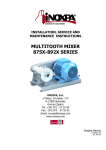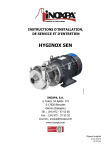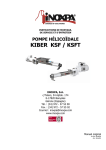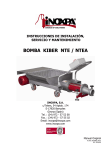Download KIBER NTE / NTEA PUMP
Transcript
INSTALLATION, SERVICE AND INSTRUCTIONS KIBER NTE / NTEA PUMP INOXPA, S.A. c/Telers, 54 Aptdo. 174 E-17820 Banyoles Girona (Spain) Tel. : (34) 972 - 57 52 00 Fax. : (34) 972 - 57 55 02 Email: [email protected] www.inoxpa.com Original Manual 01.621.30.00EN_RevC ED. 2010/09 EC DECLARATION OF CONFORMITY (according to Directive 2006/42/EC, annex II, part A) INOXPA, S.A. C/ Telers, 54 17820 Banyoles (Girona) - SPAIN Manufacturer: Hereby declares, that the product: HELICOIDAL IMPELLER PUMP KIBER NTE / NTEA Name Type conforms to the specifications of the Council Directive: Machine Directive 2006/42/EC, and complies with the essential requirements of the Directive and Harmonised Standards: UNE-EN ISO 12100-1/2:2004 UNE-EN 809/AC:2001 UNE-EN ISO 13857:2008 UNE-EN 953:1997 UNE-EN ISO 13732-1:2007 Low Voltage Directive 2006/95/CE (what repeal 73/23/EEC Directive), and are conforms with UNE-EN 60204-1:2006 and UNE-EN 60034-1:2004 EMC Directive 2004/108/CE (what repeal 89/336/CEE Directive), and are conforms with UNE-EN 60034-1:2004 In compliance with the Regulations (CE) nº 1935/2004, relating to materials and articles intended to come into contact with foodstuff (repeal Directive 89/109/EEC), the materials in contact with the product do not transfer their components in quantities which may jeopardise consumer’s health or safety Banyoles, 2012 1. Safety 1.1. INSTRUCTIONS MANUAL This manual contains information about the receipt, installation, operation, assembly, disassembly and maintenance of the Kiber NTE/NTEA pump. The information published in the instruction manual is based on updated information. INOXPA reserves the right to modify this instruction manual without prior notice. 1.2. START-UP INSTRUCTIONS This Instructions Manual contains essential and useful information for properly operating and maintaining your pump. Read these instructions carefully before starting up the pump; become familiar with the operation and use of your pump and follow the instructions closely. These instructions should be kept in a safe location near the installation. 1.3. SAFETY 1.3.1. Warning symbols Danger for persons in general Danger of injury caused by rotating equipment parts. Electrical danger Danger! Caustic or corrosive agents. Danger! Suspended loads Danger to the correct operation of the equipment. Commitment to safety at the workplace. Protective goggles requirement. 1.4. GENERAL SAFETY INSTRUCTIONS Read this Instructions Manual carefully before installing the pump and starting it up. Contact INOXPA in case of doubt. 1.4.1. During installation The Technical Specifications of Chapter 8 should always be observed. Never start up the pump before it has been connected to the tubing. Check that the motor specifications meet the requirements, especially when working under conditions that involve the risk of explosion. During the installation, all the electric work should be carried out by authorised personnel. 1.4.2. During operation The Technical Specifications of Chapter 8 should always be observed. Under no circumstances can the limit values specified be exceeded. NEVER touch the pump or the tubes during operation when the pump is being used to decant hot fluids or when it is being cleaned. The pump contains moving parts. Never place your fingers inside the pump while the pump is in operation. ED. 2010/09/ 1.Safety 3 NEVER operate the pump with the suction and delivery valves closed. NEVER spray the electrical motor directly with water. The protection standard for the motor is IP-55: Protection against dust and sprayed water. 1.4.3. During maintenance The Technical Specifications of Chapter 8 should always be observed. NEVER dismantle the pump before the tubes have been emptied. Remember that some of the fluid will always remain in the pump housing (when no drainage is provided). Note that the pumped fluid may be dangerous or very hot. Consult the regulations in effect in each country for these cases. Do not leave parts loose on the floor. ALWAYS disconnect the pump from the power supply before starting maintenance work. Remove the fuses and disconnect the cables from the motor terminals. All electrical work should be carried out by authorised personnel. 1.4.4. Compliance with the instructions Any non-fulfilment of the instructions may result in a risk for the operators, the environment and the machine, and may result in the loss of your right to claim damages. This non-fulfilment may result in the following risks: Failure of important functions of the machines/plant. Failure of specific maintenance and repair procedures. Possibility of electric, mechanical and chemical risks. Will place the environment in danger due to the release of substances. 1.4.5. Guarantee Any warranty provided shall immediately be cancelled and void ipso jure, and WINE PUMPS shall be compensated for any product liability claim from third parties, if: the service and maintenance work was not carried out in accordance with the service instructions, or the repair work has not been carried out by our personnel or it has been conducted without our written authorization; our equipment has been changed without prior written authorization; the parts or lubricants used are not original INOXPA parts and products; the materials were used incorrectly or negligently, or not in accordance with these instructions and their intended use; pump parts were damaged by excessive pressure owing to the lack of a safety valve. The General Delivery Terms already provided also apply. No change can be made to the equipment without prior discussion with the manufacturer. For your safety, please use original spare parts and accessories. The use of other parts will exempt the manufacturer from any liability. The service terms can only be changed with prior written authorisation from INOXPA. Please do not hesitate to contact us in case of doubts or if more complete explanations are required on specific data (adjustments, assembly, disassembly, etc.). 4 1.Safety ED. 2010/09/ 2. Table of Contents 1. Safety 1.1. 1.2. 1.3. 1.4. Instructions manual ......................................................................................................... 3 Start-up instructions ........................................................................................................ 3 Safety ............................................................................................................................. 3 General safety instructions ............................................................................................... 3 2. Table of Contents 3. General information 3.1. Description...................................................................................................................... 6 3.2. Range of application ........................................................................................................ 6 4. Installation 4.1. 4.2. 4.3. 4.4. 4.5. 4.6. 4.7. 5. Pump receipt ................................................................................................................... 7 Transport and storage ..................................................................................................... 7 Location .......................................................................................................................... 8 Tubes ............................................................................................................................. 8 Shut-off valves ................................................................................................................ 8 Electrical installation ........................................................................................................ 8 level sensor (OPTIONAL) ................................................................................................. 9 Start-up 5.1. Start-up .........................................................................................................................10 6. Troubleshooting 7. Maintenance 7.1. 7.2. 7.3. 7.4. 8. Technical Specifications 8.1. 8.2. 8.3. 8.4. 8.5. 8.6. 8.7. 8.8. ED. 2010/09/ General information ........................................................................................................12 Storage ..........................................................................................................................12 Cleaning ........................................................................................................................12 Dismantling / assembly of the pump ................................................................................13 Technical Specifications ..................................................................................................16 Weights .........................................................................................................................16 kiber NTE pump dimensions ............................................................................................17 kiber NTEA pump dimensions ..........................................................................................17 kiber NTE pump .............................................................................................................18 Kiber NTE pump parts list ...............................................................................................19 Kiber NTEA pump ...........................................................................................................20 Kiber NTEA pump parts list .............................................................................................21 2.Table of Contents 5 3. General information 3.1. DESCRIPTION With a compact and robust design, INOXPA’s Kiber NTE pumps form part of our range of positive-displacement pumps with helical rotor, intended for the wine industry. NTEA version is supplied with a “bridge breaker” to provide a correct entry of the product to the feeder screw. The hydraulic parts that form the pump are the rotor and the stator. The rotor is a round-section worm. The stator has two ribs and its pitch doubles that of the rotor, thus allowing empty cavities between the stator and the rotor. These cavities are used to transport the fluid. When the rotor turns within the stator, the cavities move longitudinally from the suction area to the discharge nozzle. This type of pump is appropriate for pressures of up to 6 bars. All pump parts in contact with the pumped product are made of stainless steel AISI 304L. The stator is made of PERBUNAN with a hardness particular to this application. The most significant build details of this type of pump are as follows: Pump mounted on trolley Stainless steel hopper with drain Gearbox drive with conical gears Switchboard with stop/start, contactor, and emergency stop. Level sensor or product detector (optional) Frequency converter (optional) This equipment is suitable for his use in food process. 3.2. RANGE OF APPLICATION Each pump has performance limits. The pump was selected for certain pumping conditions at the time the order was placed. INOXPA shall not be liable for any damages resulting from the incompleteness of the information provided by the purchaser (nature of the fluid, RPM, etc.). 6 3.General information ED. 2010/09/ 4. Installation 4.1. PUMP RECEIPT INOXPA cannot be held responsible for any damage to the equipment during transport or unpacking. Visually check that the packaging is not damaged. The pump will be accompanied by the following documents: Dispatch notes. Pump Instructions and Service Manual. Motor Instructions and Service Manual (*) (*) if the pump is supplied with a motor from INOXPA. Unpack the pump and check the following: • • • The pump delivery connections and the inside of the hopper, removing the remains of any packaging materials. Check that the pump and the motor have not suffered any damage. If the equipment is not in good condition and/or any part is missing, the carrier should draw up a report accordingly as soon as possible. 4.1.1. Pump identification Serial number Pump plate 4.2. TRANSPORT AND STORAGE KIBER NTE/NTEA pumps are too heavy to be stored manually. Lift the pump as shown below: ED. 2010/09/ 4.Installation 7 4.3. LOCATION Place the pump as close as possible to the suction tank, and if possible below the fluid level. Place the pump so as to allow sufficient space around it to access the pump and the motor. (See chapter 8. Technical specifications for dimensions and weights). Set up the pump on a flat, level surface. Install the pump so as to allow sufficient ventilation. If the pump is installed outdoors, it should be protected by a roof. Its location should enable easy access for any inspection or maintenance operations. 4.4. TUBES As a general rule, the suction and delivery tubes should be fitted in straight sections, with the least possible number of bends and accessories, in order to minimise head loss caused by friction. Ensure that pump input and output fittings are properly aligned with the tubing and of a similar diameter to the pump connections. Place the pump as close as possible to the suction tank, if possible below the fluid level, or even below the tank, to achieve the maximum static suction head. Place tube supports as close as possible to the pump’s suction inlet and delivery outlet. 4.5. SHUT-OFF VALVES The pump can be isolated for maintenance purposes. To this end, shut-off valves should be fitted to the pump’s suction and delivery connections. These valves should ALWAYS be open when the pump is operating. 4.6. ELECTRICAL INSTALLATION The connection of the electrical motors must be performed by qualified personnel. Take all necessary measures to prevent damage to connections and cables. The electrical equipment, terminals and components of the control systems may still contain electric current when switched off. Contact with them may be dangerous for operators or cause irreversible damage to the equipment. Before opening the pump, make sure that the electrical circuit is switched off. Connect up the motor following the manufacturer’s instructions. Electrical circuit diagram is supplied with a separate sheet. 8 4.Installation ED. 2010/09/ 4.7. LEVEL SENSOR (OPTIONAL) The level sensor of the NTE version has 3 detectors: one detects the maximum level, the other detects the minimum level and the third one detects the medium level. For a correct performance, the sensor must be assembled as indicated ED. 2010/09/ 4.Installation 9 5. Start-up Before starting the pump, carefully read the instructions provided in Chapter 4. Installation. 5.1. START-UP Read Chapter 8. Technical Specifications carefully. INOXPA cannot be held liable for the incorrect use of the equipment. NEVER touch the pump or the pipes when hot fluid is being pumped. 5.1.1. Checks before starting up the pump • • Fully open the shut-off valves on the suction and delivery pipes. If the fluid does not flow into the pump, prime the pump with fluid to be pumped. The pump must NEVER be run dry. • Check that the motor’s direction of rotation is correct. 5.1.2. Checks when starting up the pump • • • Check that the pump is not making any unusual noises. Check the flow pressure. Check that there are no leaks through the sealed areas. A shut-off valve on the suction pipe must not be used to regulate flow. Shut-off valves must be fully open during operation. Check the motor’s power consumption to avoid electric overload. 5.1.3. Danger signs in the hopper The hopper must show caution signs to symbolise the danger of removing any residue inside the hopper. These signs must be situated where the operators handling these residues can see them. Do not remove protective elements. Risk of injury in dangerous areas. 10 5.Start-up ED. 2010/09/ 6. Troubleshooting The following table provides solutions to problems that might arise during pump operation. The pump is assumed to have been properly installed and correctly selected for the application. Please contact INOXPA if you require technical assistance. Operating problems Probable causes Motor overload 3, 7, 8, 9. The pump does not provide enough flow or pressure 4, 5, 7, 8. No pressure on the delivery side 1, 2. Uneven delivery flow / pressure 3, 8. Noise and vibration 3, 4, 7, 8, 9, 10. The pump gets clogged 7, 8, 9, 10. Overheated pump 3, 7, 8, 9. Abnormal wear 4, 9, 10. Leaking through the packing material. 6. Probable causes Solutions 1 2 3 4 5 6 7 Wrong direction of rotation Lack of product. Pump speed too high Stator worn out or running dry. Pump speed too low Damaged or worn packing material. Delivery pressure too high 8 9 10 Fluid viscosity too high Taught tubes Foreign particles in the fluid Reverse the motor rotation direction. Fill the hopper. Reduce the pump speed. Replace the stator Increase the pump speed. Replace packing material. If necessary, reduce load losses, e.g. by increasing the diameter of the delivery tube. Reduce the pump speed. Connect the tubing to the pump avoiding taughtness. Reverse the pump rotation direction and remove foreign particles. If the problems persist, stop using the pump immediately. Contact the pump manufacturer or their representative. ED. 2010/09/ 6.Troubleshooting 11 7. Maintenance 7.1. GENERAL INFORMATION Like any other machine, this pump requires maintenance. The instructions contained in this manual cover the identification and replacement of spare parts. The instructions have been prepared for maintenance personnel and for those responsible for the supply of spare parts. Please read Chapter 8. Technical Specifications carefully. All replaced material should be duly eliminated/recycled according to the directives in effect in the area. ALWAYS disconnect the pump from the power supply before undertaking maintenance work. 7.1.1. Check packing material Regularly check that there are no leaks in the shaft area. If there are leaks through the packing material, replace it following the instructions given under the Assembly and Dismantling section. 7.2. STORAGE The pump must be completely emptied of fluid before storage. If possible, avoid exposing the components of the pump to excessively damp environments. 7.3. CLEANING Manual cleaning The use of aggressive cleaning products such as caustic soda and nitric acid may give rise to skin burns. Use rubber gloves during the cleaning process. Always use protective goggles. 7.3.1. Automatic CIP (cleaning-in-place) If the pump is installed in a system fitted with a CIP process, there will be no need for stripping. The recommended minimum liquid speed for an effective process of cleaning is 1,8 m/s (minimum Re > 100 000 at 1,0~2,5 bar). If it is not fitted with an automatic cleaning process, strip the pump pursuant to the instructions given in the section entitled Stripping and Assembly of the pump. Cleaning solutions for CIP processes. Only use clear water (chloride free) to mix with the cleaning agents: a) Alkaline solution: 1% in weight of caustic soda (NaOH) to 70ºC (150ºF) 1 Kg NaOH + 100 l. water = cleaning solution or 2.2 l. NaOH al 33% + 100 l. of water = cleaning solution b) Acid solution: 0.5% in weight of nitric acid (HNO3) to 70ºC (150ºF) 0.7 litres HNO3 to 53% + 100 l. water = cleaning solution Monitor the concentration of cleaning solutions, it could give rise to the deterioration of the pump sealing gaskets. 12 7.Maintenance ED. 2010/09/ In order to remove any remains of cleaning products, ALWAYS rinse the element in question with clean water after completing the cleaning process. 7.3.2. Automatic SIP (sterilization-in-place) The process of sterilization with steam is applied to all the equipment including the pump. Do NOT start the pump during the process of sterilization with steam. The parts/materials suffer no damage if the indications specified in this manual are observed. No cold liquid can enter the pump till the temperature of the pump is lower than 60°C (140°F). A flow by-pass is recommended to be used in order to assure the flow of sterile product after the pump. Maximum conditions during the SIP process with steam or overheated water a) b) c) d) Max. temperature: Max. time: Cooling: Materials: 140°C / 284°F 30 min Sterile air or inert gas EPDM / PTFE (recommended) FPM / NBR (not recommended) 7.4. DISMANTLING / ASSEMBLY OF THE PUMP 7.4.1. Stator, rotor and connecting rod Disassembly Loosen the nuts (54) and remove the washers (53). Remove the leg (07, from NTE-80 to NTE-120) and the discharge nozzle (34). Remove the stator (22), if necessary secure the rotor (21) by holding the connecting rod (24A). For sizes NT-80/90, remove the stator ring (30) and the O-ring (80). Remove the protection grid (46) from the hopper. Remove the screws (52B) and washers (35B) from the bolt (27) on the drive side. Remove the bolt (27), if necessary use an extractor with the bolt holes. Remove the connecting rod (24A) with the rotor (21). For NTE-60 move forward and remove it from the hopper in the body. Remove the bolt (27) from the rotor (21) as indicated above. Assembly Connect the rotor (21) to the connecting rod (24A) using the bolt (27) and secure in place with the screws (52B) and washers (35B). Mount the assembly at the front of the hopper (for NTE-60, insert it into the hopper). Connect the connecting rod (24A) to the shaft (05) using the bolt (27) and secure in place with the screws (52B) and washers (35B). For sizes NT-80/90, place the stator ring (30) and the O-ring (80) in front of the casing. Insert the stator (22), if necessary secure the rotor (21) by holding the connecting rod (24A). Mount the discharge nozzle (34) and the leg (07, from NTE-80 to NTE-120). Place the nuts (54A) and washers (53). ED. 2010/09/ 7.Maintenance 13 7.4.2. Drive shaft and packing material Disassembly Remove the drive protection (47). Remove the screws (52A) and washers (35, 35A by loosening the nuts (54) and disassembling the lantern (04), shaft (05), and drive (93) assembly. Remove the screw (52F) and the washer (35C) from the back part of the drive. Remove the screws (52C) and washers (53C) that are fixing the packing box (36). Remove the packing from the packing box (36) and the shaft (05) from the front. Once the packing has been removed, remove the gland (37) by loosening the nuts (57). Proceed to replace the gland packing rings (08G). Assembly Before introducing the new gland packing, check the condition of the surface of the shaft (05) and its packing box (36). The shaft should have a polished surface finishing. Cut the rings to the required length with a 45º angle, as shown in Figure 7.1. Check that the cuts match the shaft. Gently open the rings (Figure 7.2) to allow the passage of the shaft, and place each of the term in turn. First insert the junction and then push the rings to the end. First open radially and then axially. Figure 7.1 Figure 7.2 The rings (08G) must be in contact with each other, and the cuts of each ring must be arranged against each other forming a 120º angle. Turn the shaft (55) from time to time to facilitate the settlement of each ring. Insert the gland (37) and place the nuts (57). Fasten the nuts (57) manually and evenly, and make sure that the shaft rotates freely. Assemble the packing of the packing box (36) and the shaft (05) inside the lantern (04). Fix the screws (52C) with the washers (53C) and the shaft (05) at the back of the drive (93) with the screw (52F) and washer (35C). Let the pump operate with constant leaks for about 10 minutes, then fasten the gland (37) using the nuts (57) until the leaks are reduced to an acceptable level (15 to 20 drops/minute). A dripping leak is essential for the normal operation of the gland packing in order to avoid the overheating of the screws. When the packing has become fully compressed after successive adjustments, replace the full contents of the box (never replace the packing only partially). Always use good-quality packing. 14 7.Maintenance ED. 2010/09/ 7.4.3. Change of drive Disassembly. Loosen the screws (52E) and the washers (53E). Remove the screw (52F) and the washer (35C) and pull out the drive (93). Assembly. Insert the hollow drive shaft (93) into the drive shaft (05) and secure it with screws (52E) and washers (53E). Then secure this assembly with the screw (52F) and washer (35C). ED. 2010/09/ 7.Maintenance 15 8. Technical Specifications 8.1. TECHNICAL SPECIFICATIONS Maximum working pressure .................................................... Maximum temperature ........................................................... Noise level ............................................................................. Delivery connections ............................................................... 6 bar (87 PSI) 85ºC (NBR) 185 ºF (NBR) 60-80 dB(A) Spherical adapter (standard) Use special protection when the noise level in the operation area exceeds 85 dB(A). Pump type Power (kW) Speed (rpm) Output (m3/h) Minimum starting torque (Nm) NTE-60 3 210 8 – 11 110 NTE-80 5.5 210 20 - 25 150 NTE-90 7.5 210 25 - 35 190 NTE-100 7.5 210 40 - 50 245 NTE-120 15 170 55-70 270 (1) Nominal flow for de-stemmed grapes at 2 - 4 bar. Pump type Power (kW) Speed (r.p.m.) Output (2) (m3/h) Minimum starting torque (Nm) NTEA-80 5,5 185 10 – 18 NTEA-100 7,5 169 20 - 38 Feed Power (kW) Speed (r.p.m.) 150 1,5 60 245 1,5 60 (2) Nominal flow for fermented grapes at 2 - 4 bar. Materials Parts in contact with the product ............................................ Stator .................................................................................... Other materials for optional stators ......................................... Surface finish ......................................................................... AISI 304L NBR Check with the supplier Sand blasted Packing material Packing material .................................................................... Teflon-reinforced aramid fibre 8.2. WEIGHTS 16 Pump type Weight [Kg] Weight [lbs] NTE-60 190 420 NTE-80 295 650 NTE-90 320 705 NTE-100 345 760 NTE-120 570 1260 NTEA-80 365 805 NTEA-100 415 915 8.Technical Specifications ED. 2010/09/ 8.3. KIBER NTE PUMP DIMENSIONS PUMP TYPE DN A A1 B D E G H H2 NTE-60 100 1720 700 670 750 835 900 405 148 NTE-80 NTE-90 NTE-100 NTE-120 120 150 2150 2210 955 790 2255 1015 180 850 950 1060 2490 850 1185 1000 1100 A1 B D E 850 950 950 475 170 165 490 163 G H H2 1000 475 8.4. KIBER NTEA PUMP DIMENSIONS ED. 2010/09/ PUMP TYPE DN A NTEA-80 120 2150 NTEA-100 150 2255 790 955 1060 8.Technical Specifications 225 210 17 8.5. KIBER NTE PUMP 18 8.Technical Specifications ED. 2010/09/ 8.6. KIBER NTE PUMP PARTS LIST Position Description NTE-60 NTE-80/90 NTE-100 NTE-120 Material 01 Hopper casing 1 AISI 304 04 Lantern 1 F-1 05 Drive shaft 07 Brake support plate - 1 07A Non-vibratory foot - 2 08G Packing material 21 22 24A 1 * Rotor Stator * Connecting rod * AISI 329 F-1 - 4 Teflon-reinforced 1 AISI 304 1 Perbunan 1 AISI 304 2 AISI 329 27 Bolt 29 Upper tie bar 2 AISI 304 29A Lower tie bar 2 AISI 304 30 Stator ring 34 Discharge nozzle - 1 1 - AISI 304 35 Lantern-fixing washer 2 AISI 304 35A Lantern-fixing washer 2 AISI 304 35B Bolt washer 4 AISI 304 35C Shaft-fixing washer 1 AISI 304 36 Packing box 1 AISI 304 37 Gland 1 AISI 304 46 Protective grid 1 AISI 304 47 Drive protection 1 AISI 304 52 Hexagonal screw 16 A2 AISI 304 52A Hexagonal screw 4 A2 52B Hexagonal screw 4 A2 A2 52C Hexagonal screw 4 52D Hexagonal screw 4 A2 52E Hexagonal screw 8 A2 52F Hexagonal screw 1 A2 52G Hexagonal screw 8 A2 Flat washer 4 A2 53A Grower washer 16 A2 53B Grower washer 5 A2 53C Grower washer 4 A2 53D Grower washer 4 A2 53E Grower washer 8 A2 A2 53 54 Hexagonal nut 8 54A Hexagonal nut 4 A2 54B Hexagonal nut 8 A2 55 Pin 56 Flexible pin 2 - A2 2 F-143 57 Self-locking nut 2 A2 61 Key 1 F-114 67 Brake wheel - 2 Plastic 76 Rotary wheel 2 Polyurethane 76A Fixed wheel 2 Polyurethane 79 Trolley handle 80 O-ring 1 92 Cap nut 1 Plastic 93 Gearbox drive 1 - 97 Electrical controls 1 - * - 1 F-1 - NBR (*) Recommended spare parts ED. 2010/09/ 8.Technical Specifications 19 8.7. KIBER NTEA PUMP 20 8.Technical Specifications ED. 2010/09/ 8.8. KIBER NTEA PUMP PARTS LIST Position 01A Description NTEA-80 NTEA-100 Material Hopper casing 1 04 Lantern 1 F-1 05 Drive shaft 1 AISI 329 05A AISI 304 Blade shaft 1 AISI 304 06 Gear support 1 GG-15 07 Brake support plate - F-1 07A Non-vibratory foot - - 08G Packing material 4 Teflon-reinforced 12B Bushing cover 1 AISI 304 17C Friction bearing 2 PTFE 17D Guide bushing 1 AISI 304 21 Rotor 22 Stator 24A * * Connecting rod AISI 304 Perbunan 1 AISI 304 2 AISI 329 27 Bolt 29 Upper tie bar 2 AISI 304 29A Lower tie bar 2 AISI 304 30 Stator ring 34 Discharge nozzle * 1 1 1 1 AISI 304 AISI 304 35 Lantern-fixing washer 2 AISI 304 35A Lantern-fixing washer 2 AISI 304 35B Bolt washer 4 AISI 304 35C Shaft-fixing washer 1 AISI 304 36 Packing box 1 AISI 304 37 Gland 1 AISI 304 42 Blade 1 AISI 304 46 Protective grid 1 AISI 304 47 Drive protection 1 AISI 304 51 Hexagonal screw 6 A2 51B Hexagonal screw 1 8.8 52 Hexagonal screw 16 A2 52A Hexagonal screw 4 A2 52B Hexagonal screw 4 A2 52C Hexagonal screw 4 A2 52D Hexagonal screw 4 A2 52E Hexagonal screw 8 A2 52F Hexagonal screw 1 A2 52G Hexagonal screw 8 A2 Flat washer 4 A2 53A Grower washer 16 A2 53B Grower washer 5 A2 A2 53 53C Grower washer 4 53D Grower washer 4 A2 53E Grower washer 8 A2 54 Hexagonal nut 8 A2 54A Hexagonal nut 4 A2 54B Hexagonal nut 8 A2 55 Pin 2 A2 Stud 3 A2 55A 56 Flexible pin - F-143 57 Self-locking nut 2 A2 61 Key 1 F-114 61A Key 1 F-114 67 Brake wheel - Plastic 76 Rotary wheel 2 Polyurethane ED. 2010/09/ 8.Technical Specifications 21 76A Fixed wheel 2 Polyurethane 79 Trolley handle 1 F-1 80 O-ring 88 Lip seal 90 Coupling 1 - 92 Cap nut 1 Plastic 93 Gearbox drive 1 - 97 Electrical controls 1 - * 1 1 NBR NBR (*) Recommended spare parts 22 8.Technical Specifications ED. 2010/09/ INOXPA, S.A. c/ Telers, 54 – PO Box 174 17820 BANYOLES (GIRONA) DELEGACIÓN NORD-ESTE / Ó DEL VALLÈS (BCN) BARBERÀ Tel: 937 297 280 Fax: 937 296 220 e-mail: [email protected] ZARAGOZA Tel: 976 591 942 Fax: 976 591 473 e-mail: [email protected] DELEGACIÓN LEVANTE PATERNA (VALENCIA) Tel: 963 170 101 Fax: 963 777 539 e-mail: [email protected] DELEGACIÓN CENTRO ARGANDA DEL REY (MADRID) Tel: 918 716 084 Fax: 918 703 641 e-mail: [email protected] DELEGACIÓN STA GALDACANO (BILBAO) Tel: 944 572 058 Fax: 944 571 806 e-mail: [email protected] LA CISTÉRNIGA (VALLADOLID) Tel: 983 403 197 Fax: 983 402 640 e-mail: [email protected] LOGROÑO Tel: 941 228 622 Fax: 941 204 290 e-mail: [email protected] INOXPA SOLUTIONS LEVANTE PATERNA (VALENCIA) Tel: 963 170 101 Fax: 963 777 539 e-mail: [email protected] INOXPA SOLUTIONS FRANCE GLEIZE Tel: 33 474627100 Fax: 33 474627101 e-mail: [email protected] CHAMBLY (PARIS) Tel: 33 130289100 Fax: 33 130289101 e-mail: [email protected] ST. SEBASTIEN sur LOIRE Tel/Fax: 33 130289100 e-mail: [email protected] WAMBRECHIES Tel: 33 320631000 Fax: 33 320631001 e-mail: [email protected] INOXPA AUSTRALIA PTY (LTD) MORNINGTON (VICTORIA) Tel: 61 3 5976 8881 Fax: 61 3 5976 8882 e-mail: [email protected] INOXPA ALGERIE ROUIBA Tel: 213 21856363 / 21851780 Fax: 213 21854431 e-mail: [email protected] INOXPA SOUTH AFRICA (PTY) LTD JOHANNESBURG Tel: 27 117 945 223 Fax: 27 866 807 756 e-mail: [email protected] INOXPA USA, Inc SANTA ROSA Tel: 1 7075 853 900 Fax: 1 7075 853 908 e-mail: [email protected] INOXPA UK LTD SURREY Tel: 44 1737 378 060 / 079 Fax: 44 1737 766 539 e-mail: [email protected] S.T.A. PORTUGUESA LDA VALE DE CAMBRA Tel: 351 256 472 722 Fax: 351 256 425 697 e-mail: [email protected] INOXPA ITALIA, S.R.L. BALLO DI MIRANO – VENEZIA Tel: 39 041 411 236 Fax: 39 041 5128 414 e-mail: [email protected] INOXPA SKANDINAVIEN A/S HORSENS (DENMARK) Tel: 45 76 286 900 Fax: 45 76 286 909 e-mail: [email protected] IMPROVED SOLUTIONS INOXPA INDIA PVT. LTD. Maharashtra, INDIA. Tel: 91 2065 008 458 INOXPA SPECIAL PROCESSING EQUIPMENT, CO., LTD. JIAXING (China) Tel.: 86 573 83 570 035 / 036 Fax: 86 573 83 570 038 INOXRUS MOSCOW (RUSIA) Tel / Fax: 74 956 606 020 e-mail: [email protected] INOXPA WINE SOLUTIONS VENDARGUES (FRANCE) Tel: 33 971 515 447 Fax: 33 467 568 745 e-mail: [email protected] / INOXPA UCRANIA KIEV Tel: 38 050 720 8692 e-mail: [email protected] Tel: 34 972575200 Fax: 34 972575502 e-mail: [email protected] www.inoxpa.com VALE DE CAMBRA Tel: 351 256 472 140 / 138 Fax: 351 256 472 130 e-mail: [email protected] DELEGACIÓN SUR JEREZ DE LA FRONTERA (CÁDIZ) Tel / Fax: 956 140 193 e-mail: [email protected] [email protected] SAINT PETERSBURG (RUSIA) Тel: 78 126 221 626 / 927 Fax: 78 126 221 926 e-mail: [email protected] [email protected] In addition to our branch offices, INOXPA operates with an independent distributor network which encompasses a total of more than 50 countries throughout the world. For more information consult our web page: www.inoxpa.com This information is a guideline only. We reserve the right to modify any material or characteristic without prior notice.























